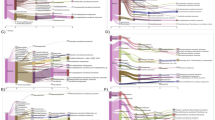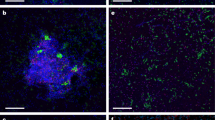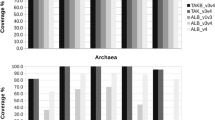Abstract
Methylocella spp. are facultative methanotrophs, which are able to grow not only on methane but also on multicarbon substrates such as acetate, pyruvate or malate. Methylocella spp. were previously thought to be restricted to acidic soils such as peatlands, in which they may have a key role in methane oxidation. There is little information on the abundance and distribution of Methylocella spp. in the environment. New primers were designed, and a real-time quantitative PCR method was developed and validated targeting Methylocella mmoX (encoding the α-subunit of the soluble methane monooxygenase) that allowed the quantification of Methylocella spp. in environmental samples. We also developed and validated specific PCR assays, which target 16S rRNA genes of known Methylocella spp. These were used to investigate the distribution of Methylocella spp. in a variety of environmental samples. It was revealed that Methylocella species are widely distributed in nature and not restricted to acidic environments.
Similar content being viewed by others
Introduction
Methylocella spp. are aerobic facultative methanotrophs (Alphaproteobacteria), with three validated species, M. palustris, M. silvestris and M. tundrae, isolated from acidic soils (Dunfield et al., 2003; Dedysh et al., 2000, 2004). M. silvestris BL2, which can grow on a variety of multicarbon substrates (Dedysh et al., 2005; Theisen et al., 2005), oxidizes methane using the soluble methane monooxygenase encoded by the operon mmoXYBZDC. Methylocella spp. lack the particulate methane monooxygenase encoded by the pmoCAB operon, which is present in all other methanotrophs (Dedysh et al., 2000, 2004; Dunfield et al., 2003). Although a few studies have detected Methylocella-related 16S rRNA genes in different environments (for example, Dunfield et al., 2003; Dedysh et al., 2000, 2004; Chen et al., 2008a, 2008b; Cockell et al., 2009; Fabiani et al., 2009; Han et al., 2009), there is little information on the distribution and abundance of Methylocella. Current molecular techniques for example, pmoA microarray (Bodrossy et al., 2003) and real-time quantitative PCR (qPCR) (Kolb et al., 2003; Tuomivirta et al., 2009), that are commonly applied to study the diversity and abundance of methanotrophs, would not detect Methylocella, as these methods target pmoA. Therefore, we aimed in this study (1) to develop Methylocella 16S rRNA gene-targeting PCR-based assays to assess the environmental distribution of Methylocella, and (2) to design Methylocella mmoX primers and develop a mmoX-targeted qPCR assay to enumerate Methylocella in environmental samples.
Results and discussion
Methylocella-related 16S rRNA gene-targeting PCR assays were developed using the primers Type IIF (Chen et al., 2007) and Mcell-1445 (Dedysh et al., 2005). Primer Type IIF was originally designed to detect 16S rRNA genes of type II methanotrophs, including the genus Methylocella, whereas primer Mcell-1445 was originally designed as a Methylocella 16S rRNA gene fluorescent in situ hybridization probe. PCR conditions were optimized and validated with DNA from pure cultures of known methanotrophs (for methodology, see Supplementary Information). Specificity of these primers to detect Methylocella 16S rRNA genes in DNA extracted from environmental samples was verified by constructing clone libraries using seven samples that were found to be positive for the 16S rRNA gene PCR products of Methylocella either by a direct and/or by a nested PCR approach (see Table 1 for samples analyzed by clone libraries). These seven samples were chosen to cover a wide range of pH values ranging from moderately acidic to very alkaline. Over 82% of the 16S rRNA gene sequences from these clone libraries were closely related (>97% identity) to Methylocella, and the remainder were related to 16S rRNA genes from Alphaproteobacteria and Gammaproteobacteria (Hyphomicrobium, Methylobacter) or Bacteroidetes (Flexibacter) (data not shown). The distribution of these non-Methylocella sequences was random across these samples. DNA extracted from various environmental samples was PCR-screened for Methylocella-related 16S rRNA genes (Table 1). Among 23 samples originating from diverse locations, Methylocella-related 16S rRNA gene PCR products were detected in 15 samples. Of these, six were positive for Methylocella-related 16S rRNA genes using a direct PCR approach. All these six samples were acidic, suggesting a higher abundance of Methylocella in these environments compared with other samples that were more neutral or alkaline in nature and which required a nested PCR approach for detection of Methylocella. In fact Methylocella-related 16S rRNA genes were detected not only from acidic and neutral environments, but also from alkaline environments such as Lonar Lake sediment, India (pH 10.0) (Table 1). These findings suggest that Methylocella is not limited to acidic pH in nature, despite being originally isolated from an acidic soil. Recently Fabiani et al. (2009) and Han et al. (2009) detected Methylocella-related 16S rRNA gene sequences in DNA extracted from an alkaline waste-treatment plant soil (pH 9), Italy, and an alkaline Chinese coal mine soil (pH 9), respectively. On the basis of our survey and the findings of these authors, it is evident that Methylocella are more widely distributed in nature than previously thought. It is interesting to note that no sequences were detected from high-salinity environments. To the best of our knowledge, there are no previously published reports of marine Methylocella sequences, suggesting that salinity may restrict the diversity of this genus. We found Methylocella in soils associated with a wide diversity of vegetation (Table 1), therefore these data do not permit any conclusions to be drawn regarding particular Methylocella–plant associations.
To enumerate Methylocella populations in environmental samples, a Methylocella mmoX gene-targeting SYBR-Green based qPCR assay was developed targeting mmoX specific for Methylocella spp. Functional gene primers mmoXLF (5′-GAAGATTGGGGCGGCATCTG-3′) and mmoXLR (5′-CCC AATCATCGCTGAAGGAGT-3′) were designed based on mmoX sequences available in GenBank using the ARB program (Ludwig et al., 2004). Although activity cannot be inferred from its presence, the use of mmoX rather than the 16S rRNA gene, by restricting the investigation to the functional group being studied, enables a much higher sensitivity of detection in complex environments (McDonald et al., 2008). PCR conditions were optimized and validated with DNA from pure cultures of known methanotrophs (for methodology, see Supplementary Information). Clone library analysis of mmoX PCR products retrieved from five environmental samples (Table 1) indicated that over 84% of the mmoX sequences were closely related (>97% identity) to Methylocella spp. and the remainder were related to mmoX genes of other methanotrophs, for example Methylobacter, Methylocystis or Methylococcus (data not shown). Detection of a certain level of non-target sequences by primers designed to target a particular bacterial genus has earlier been observed (Fierer et al., 2005). The qPCR assay was validated by spiking Ufton landfill cover soil (United Kingdom) with known amounts of M. silvestris BL2 cells (ranging from 103 to 105 cells g−1 soil), and by detecting the mmoX copies from the spiked soil (Figure 1b). Ufton landfill cover soil was chosen for the spiking study because we did not detect any Methylocella-related 16S rRNA genes from this soil, which supports the earlier observation of Héry et al. (2008), who also did not detect Methylocella spp. from this location. The detection limit of the qPCR assay was 103 cells g−1 of soil. The amplification efficiency of the reactions was between 80% and 104% (slope −3.92 to −3.27). Extraction and detection efficiency from the spiked soil was 88–111% (Figure 1b). The presence of Methylocella in amplified qPCR products was confirmed by clone library analysis (data not shown). The abundance of Methylocella detected in selected environmental samples varied from 0.9 (±0.2) × 106 (Colne Estuary sediment, Essex, UK) to 3.3 (±0.6) × 106 cells g−1 (Hornavan, Sweden) (Figure 1a). Methylocella in Lonar Lake sediment (India) and Arctic soil (Svalbard, Arctic) were below the limits of detection. However, it was surprising to see that the abundance of Methylocella in the Svalbard Arctic soil was below the limits of detection, as we detected Methylocella 16S rRNA gene PCR products with these samples using the direct PCR approach. Failure to detect Methylocella-related mmoX genes in Arctic soil (Svalbard, Arctic) might be accounted for by the fact that there is one copy of mmoX in the genome of M. silvestris compared with two copies of the 16S rRNA gene. There are no previous qPCR data on the abundance of Methylocella in the environment; however, using fluorescent in situ hybridization, Dedysh et al. (2001) showed that the numbers of Methylocella spp. in Sphagnum peat was ∼ 106 cells g−1 of wet soil. The abundance of Methylocella that we detected in peat soil (Moor House peat) was 2.3 (±0.6) × 106 copies g−1 of wet soil (Figure 1a), which is in good agreement with the data of Dedysh et al. (2001). In contrast, the total number of pmoA copies in DNA extracted from these selected environmental samples varied from 1.8 (±0.1) × 107 (Colne Estuary sediment, Essex, UK) to 3.8 (±0.5) × 109 pmoA copies g−1 (Hornavan, Sweden) (Supplementary Table 1). The qPCR protocol developed for Methylocella spp., in parallel with investigations into the activity of these organisms, can now be applied to study the effects of environmental parameters, for example availability of alternative carbon sources, salinity, vegetation type or pH, on the distribution and abundance of Methylocella in many environments.
Accession codes
References
Bodrossy L, Stralis-Pavese N, Murrell JC, Radajewski S, Weilharter A, Sessitsch A . (2003). Development and validation of a diagnostic microbial microarray for methanotrophs. Environ Microbiol 5: 566–582.
Chen Y, Dumont MG, Cébron A, Murrell JC . (2007). Identification of active methanotrophs in a landfill cover soil through detection of expression of 16S rRNA and functional genes. Environ Microbiol 9: 2855–2869.
Chen Y, Dumont MG, McNamara NP, Chamberlain PM, Bodrossy L, Stralis-Pavese N et al. (2008a). Diversity of the active methanotrophic community in acidic peatlands as assessed by mRNA and SIP-PLFA analyses. Environ Microbiol 10: 446–459.
Chen Y, Dumont MG, Neufeld JD, Bodrossy L, Stralis-Pavese N, McNamara NP et al. (2008b). Revealing the uncultivated majority: combining DNA stable-isotope probing, multiple displacement amplification and metagenomic analyses of uncultivated Methylocystis in acidic peatlands. Environ Microbiol 10: 2609–2622.
Cockell CS, Olsson-Francis K, Herrera A, Meunier A . (2009). Alteration textures in terrestrial volcanic glass and the associated bacterial community. Geobiology 7: 50–65.
Dedysh SN, Liesack W, Khmelenina VN, Suzina NE, Trotsenko YA, Semrau JD et al. (2000). Methylocella palustris gen. nov., sp. nov., a new methane-oxidizing acidophilic bacterium from peat bogs, representing a novel subtype of serine-pathway methanotrophs. Int J Syst Evol Microbiol 50: 955–969.
Dedysh SN, Derakshani M, Liesack W . (2001). Detection and enumeration of methanotrophs in acidic Sphagnum peat by 16S rRNA fluorescence in situ hybridization, including the use of newly developed oligonucleotide probes for Methylocella palustris. Appl Environ Microbiol 67: 4850–4857.
Dedysh SN, Berestovskaya YY, Vasylieva LV, Belova SE, Khmelenina VN, Suzina NE et al. (2004). Methylocella tundrae sp. nov., a novel methanotrophic bacterium from acidic tundra peatlands. Int J Syst Evol Microbiol 54: 151–156.
Dedysh SN, Knief C, Dunfield PF . (2005). Methylocella species are facultatively methanotrophic. J Bacteriol 187: 4665–4670.
Dunfield PF, Khmelenina VN, Suzina NE, Trotsenko YA, Dedysh SN . (2003). Methylocella silvestris sp. nov., a novel methanotroph isolated from an acidic forest cambisol. Int J Syst Evol Microbiol 53: 1231–1239.
Fabiani A, Gamalero E, Castaldini M, Cossa GP, Musso C, Pagliai M et al. (2009). Microbiological polyphasic approach for soil health evaluation in an Italian polluted site. Sci Total Environ 407: 4954–4964.
Fierer N, Jackson JA, Vilgalys R, Jackson RB . (2005). Assessment of soil microbial community structure by use of taxon-specific quantitative PCR assays. Appl Environ Microbiol 71: 4117–4120.
Han B, Chen Y, Abell G, Jiang H, Bodrossy L, Zhao J et al. (2009). Diversity and activity of methanotrophs in alkaline soil from a Chinese coal mine. FEMS Microbiol Ecol 70: 40–51.
Héry M, Singer AC, Kumaresan D, Bodrossy L, Stralis-Pavese N, Prosser JI et al. (2008). Effect of earthworms on the community structure of active methanotrophic bacteria in a landfill cover soil. ISME J 2: 92–104.
Kolb S, Knief C, Stubner S, Conrad R . (2003). Quantitative detection of methanotrophs in soil by novel pmoA-targeted real-time PCR assays. Appl Environ Microbiol 69: 2423–2429.
Ludwig W, Strunk O, Westram R, Richter L, Meier H, Yadhukumar et al. (2004). ARB: a software environment for sequence data. Nucleic Acids Res 32: 1363–1371.
McDonald IR, Bodrossy L, Chen Y, Murrell JC . (2008). Molecular ecology techniques for the study of aerobic methanotrophs. Appl Environ Microbiol 74: 1305–1315.
Theisen AR, Ali HA, Radajewski S, Dumont MG, Dunfield PF, McDonald IR et al. (2005). Regulation of methane oxidation in the faculative methanotroph Methylocella sylvestris BL2. Mol Microbiol 55: 682–692.
Tuomivirta TT, Yrjala K, Fritze H . (2009). Quantitative PCR of pmoA using a novel reverse primer correlates with potential methane oxidation in Finnish fen. Res Microbiol 160: 751–756.
Acknowledgements
We thank John Pearman and Dr Kevin Purdy of the University of Warwick, UK; Nick Ostle of the Centre for Ecology and Hydrology, UK; Maria Briones of the University of Vigo, Spain; Graeme Nicol, University of Aberdeen; David Wardle, Umeå University, Sweden; Paul Antony, National Centre for Cell Science, Pune, India; and Susan Crow, the University of Hawaii, USA for providing the environmental samples used in these analyses. We thank Hélène Moussard for critical reading of this manuscript. This work was funded by the Natural Environment Research Council, UK through grant NE/E016855/1. MT Rahman is supported through a University of Warwick Overseas Research Studentship. Sequences from this study were deposited at the GenBank under accession numbers GU944897–GU944935.
Author information
Authors and Affiliations
Corresponding author
Additional information
Supplementary Information accompanies the paper on The ISME Journal website
Rights and permissions
About this article
Cite this article
Rahman, M., Crombie, A., Chen, Y. et al. Environmental distribution and abundance of the facultative methanotroph Methylocella. ISME J 5, 1061–1066 (2011). https://doi.org/10.1038/ismej.2010.190
Received:
Revised:
Accepted:
Published:
Issue Date:
DOI: https://doi.org/10.1038/ismej.2010.190
Keywords
This article is cited by
-
Identification of active gaseous-alkane degraders at natural gas seeps
The ISME Journal (2022)
-
Reducing methane emission by promoting its oxidation in rhizosphere through nitrogen-induced root growth in paddy fields
Plant and Soil (2022)
-
Impacts of The Wetland Sedge Carex aquatilis on Microbial Community and Methane Metabolisms
Plant and Soil (2022)
-
Genome Scale Metabolic Model of the versatile methanotroph Methylocella silvestris
Microbial Cell Factories (2020)
-
Novel facultative Methylocella strains are active methane consumers at terrestrial natural gas seeps
Microbiome (2019)




